

The Five Tenets of Personalized Learning. Cross-posted from the Corwin Connect Blog.
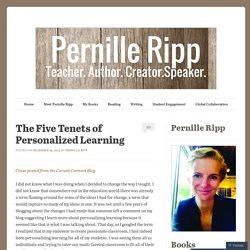
How Meditation Can Help Students Master Life. Some of the most successful people in the world meditate, including Josh Waitzkin, the only person to have won a championship in every category of chess.
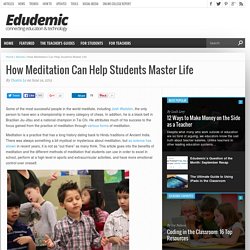
In addition, he is a black belt in Brazilian Jiu-Jitsu and a national champion in Tai Chi. He attributes much of his success to the focus gained from the practice of meditation through various forms of meditation. Guided Reflection: How Can We Use Metaphor to Reflect on Learning in a Meaningful Way? Learning is a process with two key phases: action and reflection.

We have an experience, we reflect on the experience, we expand our understanding by making new connections, and then we act, trying something new with the learning. Teachers describe this as instruction and assessment. Instruction is the action, the doing, the experience. Assessment is reflecting on the impact of the learning on the self or the student.
The current model for learning design in Ontario schools is to begin a new lesson with a Minds On task, something to trigger prior knowledge or spark curiosity. Why I struggle with learning objectives and success criteria. A strenuous soul hates cheap success.Ralph Waldo Emerson Broadly, I’m in favour of sharing with students the intention behind what they are being asked to do.
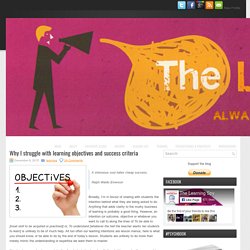
Anything that adds clarity to the murky business of learning is probably a good thing. However, an intention (or outcome, objective or whatever you want to call it) along the lines of To be able to [inset skill to be acquired or practised] or, To understand [whatever the hell the teacher wants her students to learn] is unlikely to be of much help. Carolyn Perlini sur Twitter : "Delivering effective feedback to students:...
Ben White sur Twitter : "Differentiate Success Criteria, Not Learning Intentions #TSNet #ACTLearn #aussieED #REELRPS... Inspiring Progress Toward Learning Goals. Editor's note: This post is co-authored by Marcus Conyers who, with Donna Wilson, is co-developer of the M.S. and Ed.S.

Brain-Based Teaching degree programs at Nova Southeastern University. The topic of metacognition can seem quite abstract -- a complex concept for students to embrace. But it is worth the effort to develop a metacognitive mindset in setting goals for learning and in monitoring progress toward achieving those goals. For teachers empowering students to think about their thinking with the aim of improving learning, it can be truly inspiring when they see the resulting changes in students' motivation, resilience, and learning gains. A 2014 study by Veenman and colleagues suggests that metacognition, or "cognition about cognition," may account for some 40 percent of the variation in learning achievement across a range of outcomes. Let's consider a common scenario. Learning With -- and Without -- Metacognition Goal Setting and the Brain Notes. How (and Why) I Stopped Saying, “I like the way you…”
View Original Photo For a long time, when I wanted to give students positive feedback about their work or behavior, I began with some version of, “I like the way you…” “Jeremy, I like the way you’re working so hard on that math challenge!”
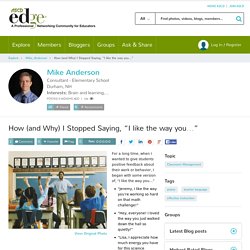
“Hey, everyone! I loved the way you just walked down the hall so quietly!” Using feedback to move forward. Giving focused feedback has removed the fear of the unknown for Christine Hills’ students and freed them up to become more confident writers.
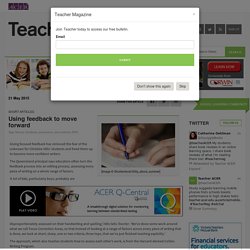
The Queensland principal says educators often turn the feedback process into an editing process, assessing every piece of writing on a whole range of factors. ‘A lot of kids, particularly boys, probably are disproportionately assessed on their handwriting and spelling,’ Hills tells Teacher. ‘We've done some work around what we call Focus Correction Areas, so that instead of looking at a range of factors across every piece of writing that is done, we look at short, sharp, one or two criteria, three tops, that we've just finished teaching explicitly.’ The approach, which also teaches students how to assess each other’s work, is from the Harvard-derived Collins Writing Program. How to Reflect On Your Teaching Infographic. Teacher Infographics Reflective practice occurs when teachers step back and evaluate the learning environment.

The teacher looks at himself or herself. They ask, “How can this be better?” They identify what went right or wrong. It occurs both during the learning events and after. Via: anethicalisland.wordpress.com Embed This Education Infographic on your Site or Blog! Learning Goals Anchor. Great Teachers Are Great Learners - AITSL. Tips to Engage and Guide Reluctant Students Toward Learning Goals. Today's Target: A New Classroom Management Tool For Setting Goals. Let me introduce myself. How to Help Students Set and Reach Their Goals. {*style:<i> “If you don’t know where you are going, you’ll end up someplace else.” Yogi Berra </i>*} Do the students in your class set goals for themselves? Do they achieve these goals? Perhaps, those questions should be rephrased. It is easy to set an arbitrary goal for some point in the future; however, it is quite different to consciously choose a realistic goal to attain and develop an action plan in order to achieve it.